There’s no question that cowboy boots were made for riding.
With their slightly-raised heels, high shafts, tread-less soles and their particularly narrower insoles, working a horse in them couldn’t be easier. Walking in these very same boots however, can prove to be a cumbersome task.
This is because every single part of the boot was made to serve its purpose with precision.
The tread-less sole and pointed toe of a cowboy boot for instance, were perfect for easily slipping into stirrups. The heel would secure the boot to the stirrup while the high shaft worked to protect the rider’s leg from the constant friction while riding.
The western boot has however evolved to feature treaded soles and some even have laces. But even when all that is taken into account, walking in these shoes much like any other heeled shoes doesn’t come naturally.
In fact, some allude that cowboy boots are to men what high-heeled shoes are to women. They can be uncomfortable, wobbly and loud depending on the surface one is walking on.
Which then begs the question from many a cowboy boot lover, “how does one properly walk in cowboy boots?”
Here’s a reliable guide that will take you through any troubles you may encounter in these shoes.
How to Walk Comfortably (Confidently) In Cowboy Boots
A lot of people who don’t fancy cowboy boots argue that they just aren’t made for walking. The heel? Unbearably uncomfortable. The tread-less sole? Definite cause for injury. The toe box? Just insufferable… and so on.
This may be true to the extent that cowboy boots were primarily made for riding. But any real cowboy will tell you that these shoes can take you comfortably through the barns with equal measure as they will in a fancy restaurant.
You just need to do the following:
1. Choose the right fit
Whether or not you are going to experience comfort while walking in your cowboy boots depends on a number of factors but primarily on the question “are you wearing the right boots?”
Do the boots fit right? It doesn’t take a genius to figure out that wearing shoes that do not fit will affect your walking stature. In other words, the reason why you are walking awkwardly in those cowboy boots is because they don’t fit right.
It’s simple, you are prone to experience heel slippage while walking in cowboy boots that are a size too big.
Big boots force your heels to tip forward and therefore your weight is shifted to the front of the boots. This leads to an awkward walking stature as the feet have too much room to move about. Alternatively, the shifted weight to the front of the boot leads to an imbalance/overbalance that makes you very likely to fall.
On the other hand, shoes that are too small will squeeze your toes into the toe box and make for an awkward if not painful walking stance.
The toe box of a cowboy boot (save for those with a square-shape) is usually already narrow enough so wearing a size smaller only farther narrows the toe and heel area.
And if the boots fit too tight, the heel will pinch and result in blisters. That, or you may experience nerve irritation which may be the reason why you are always wincing in pain after stepping into your cowboy boots.
The solution? Check with the manufacture’s guide for each particular brand before purchasing their boots.
A common mistake that most men make is to approximate the size of their cowboy boots based on the size of their tennis shoes.
It just won’t work because the fit couldn’t be further apart!
One thing about cowboy boots is that there usually isn’t a standard fit. One brands’ boot size might fit you right but the same size from a different brand might run too big or too small.
Because different manufacturers have different fittings, you should physically fit them before making a purchase.
To tell whether you are wearing the right fit, rest the ball of your feet onto the heel of your boot. You should be able to stand comfortably with your weight distributed on both feet.
Another tip that you might want to consider is fitting the boots in the afternoon when your feet are at their largest to avoid purchasing a boot that will eventually fit too tightly.
Listen, shoes that fit right simply can’t be substituted. The right size and fit will save you from an awkward or uncomfortable walk and embarrassing fall.
2. Exert pressure onto the heel of the boot
Remember how shifting your weight to the front can result in an overbalance that might end up in a fall?
Well, that’s because while walking the pressure should be exerted onto the heel in order to achieve stability.
Where you rest your feet and the pressure point will therefore greatly affect how you walk.
The ball of your feet should rest on the widest part of the boot’s interior so that the toes do not feel confined or curled up at the front. This would result in an uncomfortable feel and awkward walk EVEN in boots that are APPROPRIATELY sized for you.
Do not shift your weight to the front as you will more likely stumble by overbalancing the front.
3. Walk from heel to toe
Wearing a flat shoe is different from wearing a shoe with a raised heel.
This means that while it is easier to maintain balance in flat shoes, one has to make an effort to acquire balance and stability while waking in heeled shoes.
With a flat sole, one simply places their whole foot flat onto the ground while walking. The flat sole naturally offers you stability as it is similar to walking with your bare feet.
The twist to walking in a western boot is that one should place the heel onto the ground first. The toe follows immediately after such that you are walking from heel to toe.
By that we mean that other than exerting pressure onto the heel while walking, ensure that your heel reaches the ground slightly before the toes do. Never at the same time.
In our experience, when your whole foot hits the ground at the same time, you basically walk awkwardly as your feet are not compensating for the space taken up by the raised heel.
So with the boots on, stand up and center your weight on the heel of the boot/ balls of your feet. Once your weight is centered, then proceed to walk from heel to toe and continue doing so as you push forward for the next step.
You will notice that even your posture is straighter.
If you remember the sequence that the heel should always be the first contact point with the ground, the change in your walk will give you more confidence and enable you to form a trusting relationship with your boots.
Of course, you’ll need some time to adapt to this new style of walking, which is why you should practice by wearing the boots more often and not just reserving them for a special occasion.
4. Break them in
Like we’ve hinted above, the secret to comfortably walking in cowboy boots is by simply wearing them!
Give them a little time before throwing them to the back of your shoe-rack, especially if this is the first time you are wearing cowboy boots.
The advantage to breaking in shoes is that it helps remove the stiffness that usually results in blisters. Additionally, it allows the shoes to mold to the natural contours of your feet
Walk in and around the house to expose the boots to different surfaces. The more you wear them the more acquainted they become with your feet and the ground.
You can walk around in them but if you want to quicken the break in process, then several options can be considered as we covered in our how to break in cowboy boots article.
5. Work your way up
Again, cowboy boots were initially made to serve a specific purpose. And the reason why you can’t grasp the concept of walking in them is because you are wearing them for the "wrong" purpose.
Now, before you make assumptions about how heeled shoes simply aren’t made for walking, consider this: are you trying to cross the bridge before you get there?
Have you simply shunned this footwear because you tried walking in a high-heel when you have no experience walking in a mid-heel, leave alone a high one?
Cowboy heels can in fact be used to relieve pain so the question of walking with heeled shoes should be out of the way.
The elevated heels give you arch support which can enhance comfort and relieve Achilles tendon pain. This is by shortening the Achilles tendon and reducing strain so all in all cowboy boots enhance the health of your feet.
Now that that’s out of the way; yes, cowboy boots come with Cuban heels but the heels vary in height depending on their use.
As such; comfort, grip and support can be achieved while riding in high heels that go up to two inches in height. However, if you want cowboy boots for the sole purpose for walking and are new to cowboy boots, then you ought to work your way up.
Start simple with a flat boot then work your way up with a mid-height heel. A suitable heel measurement for comfortably walking in cowboy boots is one that is less than 1.5 inches in height. You can get a good a good classic cowboy boot or Roper cowboy boot in this size as they tend to be low-heeled.
This low heel is ideal if you have to stay on your feet for several hours at a go as it will prevent tension from building up on the heel and balls of your feet
At the end of the day, you are looking for comfort and stability so work your way up only when you are comfortable.
That said, the worst mistake you can make is trying to debut your cowboy boot by wearing tall riding boots. Don’t embarrass yourself; start small.
How to Avoid Slipping In Cowboy Boots
So you now know how to avoid that awkward walk, painful pinch and that embarrassing fall but what about the tendency to slip while walking in cowboy boots?
Other than a wrong walking posture, one other thing that accounts for falling while walking in cowboy boots is having a slippery bottom that has no tread.
Sure, the tread-less sole allows for easy slippage into stirrups but just how practical are they on pavements and stairs? Especially for beginners?
It’s common for your heel to slide especially if the boots are brand new but there are a few measures that you can take to counter this.
The most obvious way to avoid slipping is to purchase boots with treaded soles.
Today, you can easily get treaded soles with non-slip traction from renowned boot manufacturers such as Ariat and Lucchese.
However, in the event that you already have tread-less boots and want to feel at home in the barn as well as in your favorite restaurant, then you can rough them up by rubbing sand paper across the bottom to increase their grip.
You can also break in the outsoles by wearing them a lot and exposing the boots to different surfaces. From tiles or carpets at home to wooden floors and cemented sidewalks, the boots will have wear and tear which will in turn increase their traction and make them less prone to sliding as you walk.
How to Walk Up Steps In Cowboy Boots
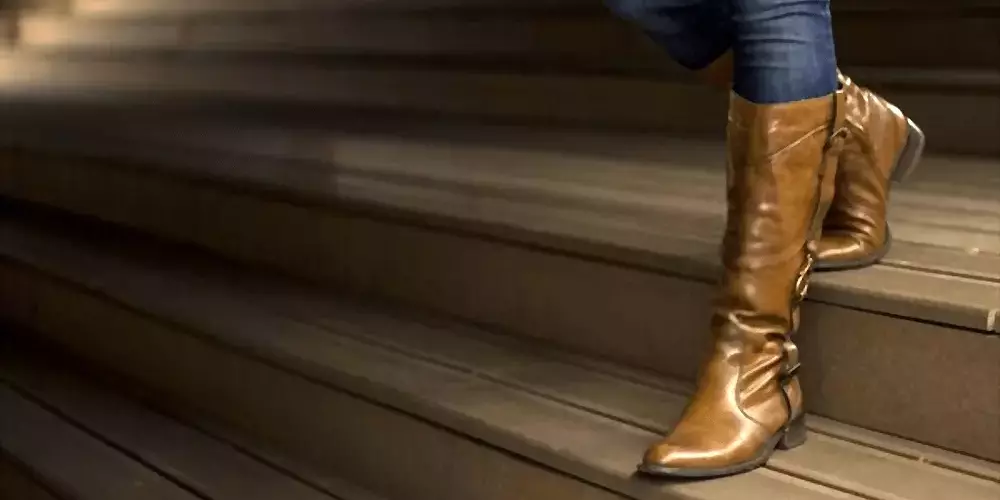
Let’s be real; walking up steps in cowboy boots isn’t the easiest task; but it can be with the right approach.
It all comes back to foot placement.
With incorrect foot placement, you might end up wobbling to the left or right depending on the direction that the heel falls off to. That, or you might end up missing a step and fall altogether.
The shaft of the boot is supporting your upper leg so your feet is where the problem lies.
When going up a climb, you want to ensure that you exert the pressure in the middle/ball of your feet to create stability.
When walking on flat ground, the pressure on the heel is more so for balance (to avoid tipping too much to the front) than it is for stability (to create a firm impact on the ground) as is the case with going up steps.
So, when walking up steps, aim to place your entire weight on the ball of your foot and lift your body up with you as you make that step. The last point of contact with the ground should be your toes.
You are basically walking from heel to toe but the difference comes in when going down the steps.
As you descend, aim to place your entire foot (heel and toe) onto the step instead of heel to toe. You are more likely to fall forward if your toes hit the ground before the balls of your feet just as you also would if you walk from heel to toe.
Be sure to hold onto the railing for extra support before you get used to it. This will help you avoid any accidental falls.
Remember; place your entire foot onto the step while descending but only place the ball of your feet on each step as you climb the stairs.
Practice doing so to the point that you do it subconsciously and in no time, you’ll be walking up and down those steps like a pro.
How to Walk Silently In Cowboy Boots

You know that infamous, clink clank sound that your heels make when walking down an empty hall? That same one that when combined with spurs creates an uncalled for orchestra?
Well, although some men don’t mind it or care for it, at the very least it can be bothersome to those around you.
The sound is particularly loud on concrete and tile floors and it gets even louder when you are carrying something that would typically weigh you down; such as a backpack.
The thud sound comes about from the design of the heel. Traditionally, the sole and the heel were made of stacked leather which is very solid. When it comes in contact with hard floors, the impact results in the click sound that is popularly associated with cowboy boots.
They can be problematic especially when working in an office setting where unnecessary noise ruins concentration and isn’t appreciated. The lack of stealth is by far one of the draws to cowboy boots but it can be remedied in one of three ways.
i) Resole the boots
Firstly and most importantly, you can get the boots resoled.
This can be done at your local shoe repair store where leather soles can be traded for softer and less noisy rubber soles. The soft rubber soles can be changed once it wears off.
Today, there are various options for boots with leather soles, rubber soles and even rubber soles and leather heels. The choice is simply yours depending on where you intend to wear the shoes and how comfortable you are with the click sound.
ii) Walk from toe to heel
Secondly, you can change your walking style such that you walk from toe to heel instead of heel to toe. Of course, this makes for a gawky walk but you can reserve this walk for office settings and avoid causing a nuisance altogether.
iii) Ensure you have the right size
Lastly, ensure that you are wearing the right size. Like we’ve said over and over again, the right fit will save you from a lot of troubles associated with cowboy boots.
If the boots fit too big, they are more likely to have that clunk sound as compared to when they fit right and the sound is reduced to a tap rather than thud.
As you can see, cowboy boots can become an everyday wear for urban environments; you just have to figure out how.
Bottom Line
Walking in cowboy boots can be an extreme sport if you don’t know how to avoid those painful blisters, that uncomfortable wobble, that annoying clicking sound and most of all that embarrassing fall.
The key to a comfortable and confident walk in cowboy boots is wearing the right sized boots, knowing where to exert pressure as you walk, knowing how to place your foot whether on flat ground or up the stairs, knowing which heel size to go for and knowing what step to take if the sound is a great nuisance to you.
Once you figure that out, the western boot should be able to feel equally at home on ground as it does on a horse.

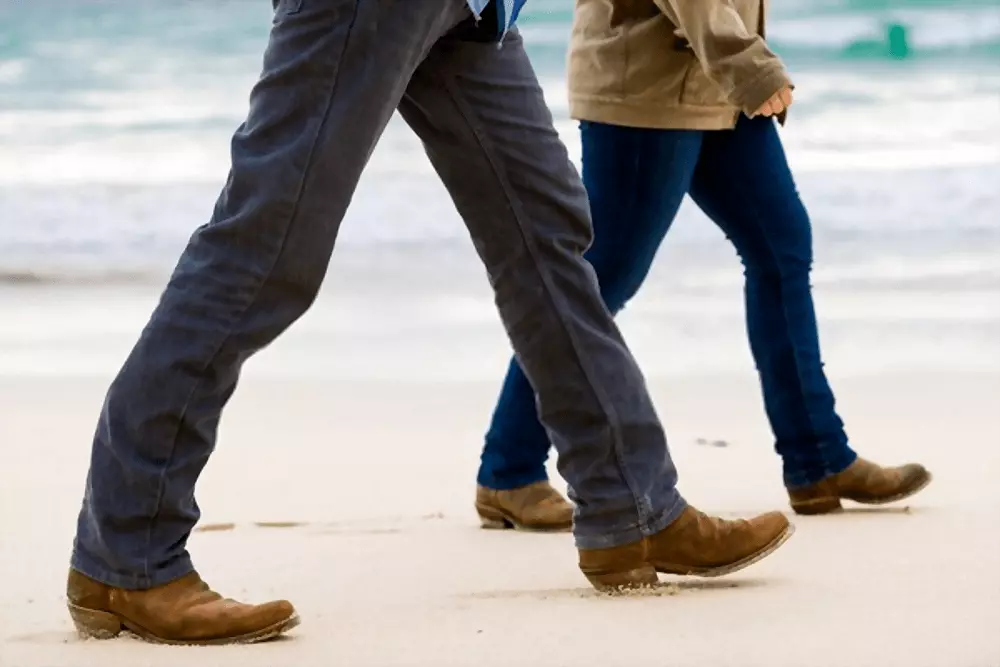

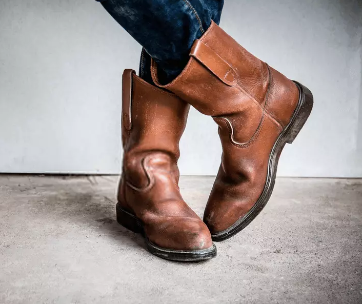
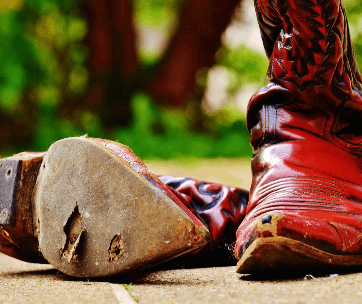

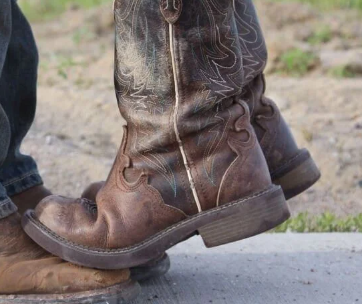

Comments
This article helped me figure out many things. I love my boots and the high heels appeal to me as I am short of stature. I was walking toe to heel because it was quieter but I will accept the click, click and try heel to toe as it will look more natural and give me a more confident gate with better posture.